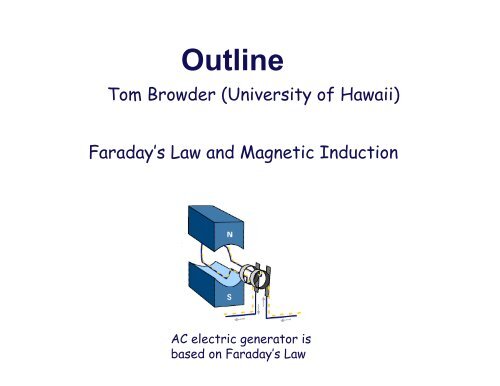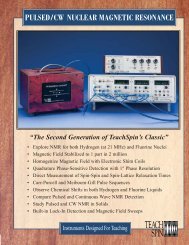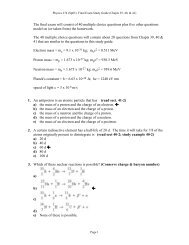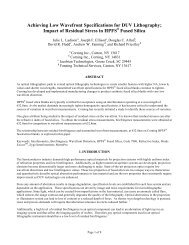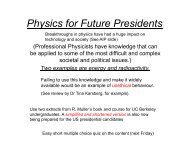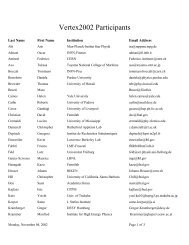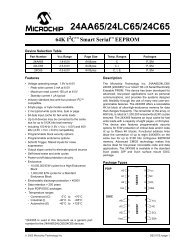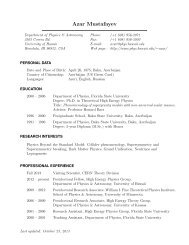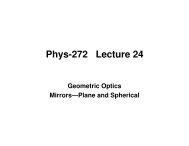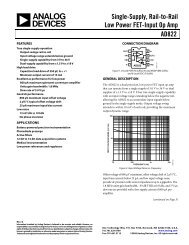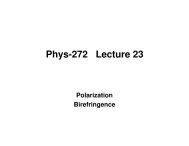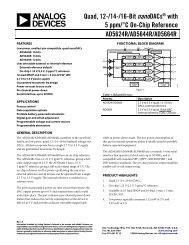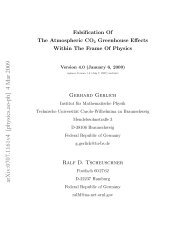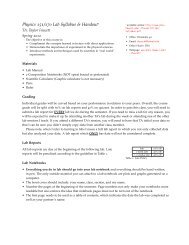Lecture 17a (pdf) - University of Hawaii
Lecture 17a (pdf) - University of Hawaii
Lecture 17a (pdf) - University of Hawaii
You also want an ePaper? Increase the reach of your titles
YUMPU automatically turns print PDFs into web optimized ePapers that Google loves.
Outline<br />
Tom Browder (<strong>University</strong> <strong>of</strong> <strong>Hawaii</strong>)<br />
Faraday’s Law and Magnetic Induction<br />
AC electric generator is<br />
based on Faraday’s Law
Headline Solar flare: Biggest in six years hits the Earth<br />
Solar flare: The Sun is in an 11-year cycle <strong>of</strong> solar<br />
flare activity, with a peak next year. Solar flares can<br />
disrupt power grids, satellites, oil pipelines and highaccuracy<br />
GPS systems
Faraday's Law<br />
dS<br />
B<br />
B
Electromagnetic Induction<br />
So far we have studied electric fields created from charges<br />
and constant magnetic fields created by moving charges.<br />
NOW we investigate effects <strong>of</strong> time varying magnetic<br />
fields on loops and we will find electric fields are induced<br />
in loops, which create EMFs and cause currents to flow.<br />
Electric generators are based on the physics <strong>of</strong><br />
electromagnetic induction and Faraday’s law.
Faraday’s Law<br />
Changing magnetic fields create electric fields<br />
Stationary magnet has<br />
fixed magnetic field<br />
in the loop and creates<br />
NO current in loop<br />
Moving magnet causes changing<br />
magnetic field in loop and<br />
creates current in loop
Coil fixed in an electromagnet;<br />
constant or changing magnetic field<br />
Magnetic field constant<br />
NO current in loop<br />
Magnetic field increasing<br />
Current in loop
History <strong>of</strong> the Discovery <strong>of</strong> Electromagnetic Induction<br />
In 1830, Joseph Henry <strong>of</strong> Princeton (invented telegraph) observed<br />
induction, “conversion <strong>of</strong> magnetism to electricity”, but did not<br />
publish and did not recognize the vast importance <strong>of</strong> this<br />
observation. Later however, he observed and published evidence<br />
for self induction.<br />
In 1831, Michael Faraday observed and published evidence <strong>of</strong><br />
electromagnetic induction and also invented the homopolar<br />
generator that converts continuous DC.<br />
Faraday at the Royal<br />
Society<br />
Faraday’s Laboratory
Faraday’s Law <strong>of</strong> Induction<br />
Recall the definition <strong>of</strong> magnetic flux is<br />
Faraday’s Law is the induced EMF in a closed loop equal the<br />
negative <strong>of</strong> the time derivative <strong>of</strong> magnetic flux change in the loop,<br />
Tricky part is<br />
figuring out the<br />
EMF direction<br />
Constant B field,<br />
no induced EMF<br />
in loop<br />
changing B field,<br />
causes induced EMF<br />
in loop
Getting the sign <strong>of</strong> the EMF in Faraday’s Law <strong>of</strong> Induction<br />
Define the loop and an area vector, A, who magnitude is the<br />
Area and whose direction normal to the surface.<br />
A<br />
The choice <strong>of</strong> vector A direction defines the direction <strong>of</strong> EMF<br />
by the right hand rule. Your thumb in A direction and then your<br />
Fingers curl in the direction <strong>of</strong> positive EMF.
Lenz’s Law – easier way!<br />
Lenz's Law: the magnetic field<br />
<strong>of</strong> any induced current opposes the change<br />
that induces it.<br />
⇒ Convenient method to determine I direction<br />
Example if an external magnetic field on a loop<br />
is increasing, the induced current creates a field<br />
opposite that reduces the net field.<br />
Heinrich Friedrich<br />
Emil Lenz<br />
(1804-1865)<br />
Example if an external magnetic field on a loop<br />
is decreasing, the induced current creates a<br />
field parallel to the that tends to increase the<br />
net field.<br />
Lenz’s Law is a consequence <strong>of</strong> cons.<br />
<strong>of</strong> energy
Lenz’s Law; consider moving magnet towards a wire loop<br />
No current<br />
and no field<br />
stationary<br />
magnet<br />
Induced field<br />
is opposite<br />
moving N<br />
side <strong>of</strong> magnet<br />
into loop<br />
Induced field<br />
is opposite<br />
moving S<br />
side <strong>of</strong> magnet<br />
into loop<br />
Repulsive force, like pushing two S poles together.
Clicker:<br />
A copper loop is placed in a non-uniform<br />
magnetic field. The magnetic field does not<br />
change in time. You are looking from the right.<br />
1) Initially the loop is stationary. What is the induced current in<br />
the loop?<br />
a) zero<br />
b) clockwise<br />
c) counter-clockwise<br />
2) Now the loop is moving to the right, the field is still constant.<br />
What is the induced current in the loop?<br />
a) zero<br />
b) clockwise<br />
c) counter-clockwise
When the loop is stationary: the flux through the ring does not change!!!<br />
⇒ dΦ/dt = 0 ⇒ there is no emf induced and no current.<br />
When the loop is moving to the right: the magnetic field at the position <strong>of</strong> the loop is<br />
increasing in magnitude. ⇒ |dΦ/dt| > 0<br />
⇒ there is an emf induced and a current flows through the ring.<br />
Use Lenz’ Law to determine the direction: The<br />
induced emf (current) opposes the change!<br />
The induced current creates a B field at the ring,<br />
which opposes the increasing external B field.
Clicker<br />
y<br />
• A conducting rectangular loop moves with<br />
constant velocity v in the +x direction<br />
through a region <strong>of</strong> constant magnetic field B<br />
in the -z direction as shown.<br />
2A<br />
• What is the direction <strong>of</strong> the induced<br />
current in the loop?<br />
(a) ccw (b) cw (c) no induced current<br />
• A conducting rectangular loop moves with<br />
constant velocity v in the -y direction and a<br />
constant current I flows in the +x direction as<br />
shown.<br />
• What is the direction <strong>of</strong> the induced<br />
2B<br />
current in the loop?<br />
X X X X X X X X X X X X<br />
X X X X X X X X X X X X<br />
X X X X X X X v X X X X X<br />
X X X X X X X X X X X X<br />
x<br />
(a) ccw (b) cw (c) no induced current<br />
y<br />
v<br />
I<br />
x
1A 2A<br />
Clicker<br />
y<br />
• A conducting rectangular loop moves with<br />
constant velocity v in the +x direction<br />
through a region <strong>of</strong> constant magnetic field B<br />
in the -z direction as shown.<br />
– What is the direction <strong>of</strong> the induced<br />
current in the loop?<br />
X X X X X X X X X X X X<br />
X X X X X X X X X X X X<br />
X X X X X X X v X X X X X<br />
X X X X X X X X X X X X<br />
x<br />
(a) ccw (b) cw (c) no induced current<br />
• There is a non-zero flux Φ B passing through the loop since<br />
B is perpendicular to the area <strong>of</strong> the loop.<br />
• Since the velocity <strong>of</strong> the loop and the magnetic field are<br />
CONSTANT, however, this flux DOES NOT CHANGE IN<br />
TIME.<br />
• Therefore, there is NO emf induced in the loop; NO current<br />
will flow!!
Clicker<br />
• A conducting rectangular loop moves with<br />
y<br />
constant velocity v in the -y direction and a<br />
constant current I flows in the +x direction as<br />
shown.<br />
• What is the direction <strong>of</strong> the induced<br />
2B<br />
current in the loop?<br />
(a) ccw (b) cw (c) no induced current<br />
v<br />
I<br />
x<br />
• The flux through this loop DOES change in time since<br />
the loop is moving from a region <strong>of</strong> higher magnetic field<br />
to a region <strong>of</strong> lower field.<br />
• Therefore, by Lenz’ Law, an emf will be induced which<br />
will oppose the change in flux.<br />
• Current is induced in the clockwise direction to restore<br />
the flux.
€<br />
Slide Wire Generator<br />
S<br />
The area is LS(t) and dS/dt equals velocity <strong>of</strong> slider<br />
ε = − d dt Φ B<br />
= − d dt<br />
∫<br />
<br />
B • dA <br />
= −<br />
d<br />
dt<br />
∫<br />
B dA<br />
= − d dt BA = − d dt BLS = −BL d dt S = −BLv
Slide Wire Generator; work and power We found<br />
S<br />
Q: How much<br />
power is dissipated, P d<br />
and power is applied, P a<br />
Ans: Assume total<br />
resistance<br />
is R, then I=Ɛ/R and<br />
P d =I 2 R=B 2 L 2 v 2 /R<br />
The power applied, P a =Fv, is the rate <strong>of</strong> work to the bar to the right<br />
against the force, F, which is pointed to the left. F=ILB= (Ɛ/R)LB =<br />
B 2 L 2 v/R. Thus P a = Fv = B 2 L 2 v 2 /R = P d ; the power put into the moving<br />
the bar equals the heat dissipated in the circuit.<br />
⇒ Power needed to move bar = Power dissipated in circuit
Slide Wire Generator; use Lenz’s Law to get I direction<br />
S<br />
Lenz’s Law says I<br />
direction creates a field<br />
that opposes change<br />
in magnetic flux.<br />
If we pull bar to right, the net magnetic flux in rectangle increases<br />
into screen, hence the I direction must induce opposite B field<br />
which is out <strong>of</strong> screen and is correct in drawing.<br />
Suppose Lenz’s law were reversed, then I would be reversed and F<br />
would go right and the bar would be accelerated to the right, w/o need<br />
<strong>of</strong> external positive work and heat would be dissipated at the same<br />
time. Thiss violates cons. <strong>of</strong> Energy, so Lenz’s law is correct.
Motional Electromotive Force<br />
In Faraday’s Law, we can induce EMF in the loop when the<br />
magnetic flux, Φ B , changes as a function <strong>of</strong> time. There are two<br />
Cases when Φ B is changing,<br />
1) Change the magnetic field (non-constant over time)<br />
2) Change or move the loop in a constant magnetic field<br />
The slide wire generator is an example <strong>of</strong> #2 and the induction <strong>of</strong><br />
EMF via moving parts <strong>of</strong> the loop is called, motional EMF.
Alternator Generator<br />
Wire loop area A rotates with respect<br />
to constant magnetic field.<br />
If the angular frequency is ω, then<br />
and EMF in the loop is
An example from Young and Freedman<br />
In a physics laboratory experiment, a coil with 200 turns enclosing an<br />
area <strong>of</strong> 122cm^2 is rotated in a time interval <strong>of</strong> 0.04s from a position<br />
where its plane is perpendicular to the earth's magnetic field to one where<br />
its plane is parallel to the field. The earth's magnetic field at the lab<br />
location is 6x10 -5 T.<br />
What is the total magnetic flux through the coil before it is rotated?<br />
What is the total magnetic flux through the coil after it is rotated?<br />
What is the average emf induced in the coil?<br />
B
Strategy for Faraday’s Law Problems<br />
B is time-varying but area <strong>of</strong><br />
current loop is fixed<br />
Area <strong>of</strong> current loop is<br />
varying but B is fixed<br />
Orientation <strong>of</strong> current loop relative to B is<br />
time-varying but B and area A are fixed
Applications <strong>of</strong> Magnetic Induction<br />
• AC Generator<br />
– Water turns wheel<br />
rotates magnet<br />
changes flux<br />
induces emf<br />
drives current<br />
• “Dynamic” Microphones<br />
(E.g., some telephones)<br />
– Sound<br />
oscillating pressure waves<br />
oscillating [diaphragm + coil]<br />
oscillating magnetic flux<br />
oscillating induced emf<br />
oscillating current in wire<br />
Question: Do dynamic microphones need a battery?
More Applications <strong>of</strong> Magnetic Induction<br />
• Tape / Hard Drive / ZIP Readout<br />
– Tiny coil responds to change in flux as the magnetic domains<br />
(encoding 0’s or 1’s) go by.<br />
Related to 2007 Nobel Prize!<br />
(for giant magnetoresistance)<br />
• Credit Card Reader<br />
– Must swipe card<br />
generates changing flux<br />
– Faster swipe larger signal<br />
If you do not move the<br />
card, will your payment be<br />
recorded ?
A component <strong>of</strong> the<br />
automobile ignition
More Applications <strong>of</strong> Magnetic Induction<br />
• Magnetic Levitation (Maglev) Trains<br />
– Induced surface (“eddy”) currents produce field in opposite<br />
direction<br />
Repels magnet<br />
Levitates train<br />
e.g. Shanghai maglev train<br />
S<br />
N<br />
“eddy” current<br />
rails<br />
– Maglev trains today can travel up to 310 mph<br />
Twice the speed <strong>of</strong> Amtrak’s fastest conventional train!<br />
– May eventually use superconducting loops to produce B-field<br />
No power dissipation in resistance <strong>of</strong> wires!
Induction cooking<br />
Special induction<br />
cookware<br />
Stove top does<br />
not become hot !!
A simplified schematic <strong>of</strong> a nuclear power plant<br />
(There are several types. For example, Chernobyl<br />
used graphite rather than boiling water.)<br />
Faraday’s Law for ac power<br />
generation !!!<br />
Concrete<br />
steel<br />
reinforced<br />
containment<br />
vessel<br />
Note: Water is a neutron moderator,<br />
provides cooling for the reactor and<br />
produces steam to run the turbine/ac<br />
generator.
• Faraday’s Law<br />
Summary<br />
– a changing magnetic flux through a loop induces a<br />
current in that loop<br />
negative sign indicates that<br />
the induced EMF opposes<br />
the change in flux<br />
• Lenz’s Law<br />
The direction <strong>of</strong> any magnetic induction<br />
effect is such as to oppose the cause <strong>of</strong><br />
the effect.


